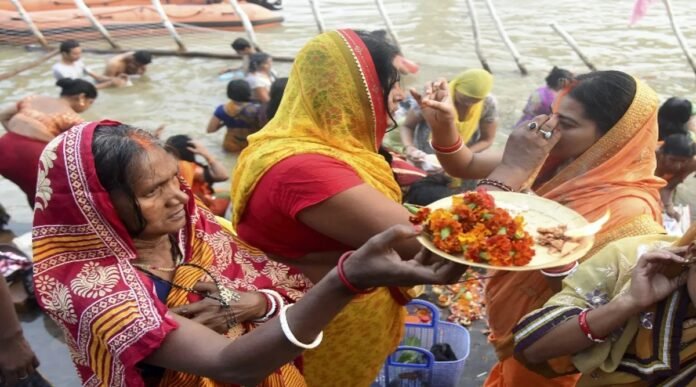
Chhath Puja, a deeply revered Hindu festival, is dedicated to Lord Surya, the Sun God, and is observed primarily in Bihar, Jharkhand, Uttar Pradesh, and parts of Nepal. Known for its rigorous rituals and devotional fasting, Chhath Puja symbolizes gratitude to the Sun God for sustaining life on Earth. This year, Chhath Puja will be observed from November 5 to November 8, 2024.
Here’s a comprehensive guide to the festival’s dates, rituals, and significance.
Chhath Puja 2024 Dates and Timings
Celebrated during the Kartik month on the sixth day after Diwali, Chhath Puja is a four-day observance filled with prayer, fasting, and rituals honoring the Sun. According to Drik Panchang, the specific timings and rituals for this year’s festival are as follows:
- November 5, 2024 (Tuesday): Nahay Khay – Sunrise at 6:35 AM, Sunset at 4:53 PM
- November 6, 2024 (Wednesday): Lohanda and Kharna – Sunrise at 6:36 AM, Sunset at 4:52 PM
- November 7, 2024 (Thursday): Sandhya Arghya (Evening Offering) – Sunrise at 6:37 AM, Sunset at 4:51 PM
- November 8, 2024 (Friday): Usha Arghya (Morning Offering) – Sunrise at 6:38 AM, Sunset at 4:50 PM
Understanding the Rituals of Chhath Puja
The festival unfolds over four days, each marked by unique and meaningful rituals. Here’s a day-by-day overview:
1. Nahay Khay (Day of Purity and Cleansing) – November 5, 2024
The first day, Nahay Khay, symbolizes purification and preparation. Devotees begin by bathing in a river or water body and preparing a simple meal that includes rice and lauki (bottle gourd) to purify themselves and their surroundings. This day marks the spiritual and physical cleansing necessary for the rigorous fasting and rituals to follow.
2. Lohanda and Kharna (Day of Fasting) – November 6, 2024
On the second day, devotees observe a day-long fast that concludes in the evening with a meal called prasad, which usually includes kheer (sweet rice pudding), fruits, and chapatis. The meal is first offered to the Sun God before being shared among family members. This day signifies devotion, self-discipline, and gratitude toward divine blessings.
3. Sandhya Arghya (Evening Offerings to the Setting Sun) – November 7, 2024
The third day is the main day of Chhath Puja, where devotees gather at riversides or ponds in the evening to offer Arghya (water offerings) to the setting sun. This act of reverence signifies gratitude for the energy and life the Sun provides. Devotees stand in knee-deep water while performing these rituals, symbolizing respect and devotion to the divine force.
4. Usha Arghya and Parana (Morning Offerings to the Rising Sun) – November 8, 2024
On the final day, devotees perform the Usha Arghya, offering water to the rising sun at dawn. After the morning rituals, the four-day fast is broken, and prasad is shared among family, friends, and the community, signifying unity, harmony, and blessings. The festival concludes with communal prayers and the distribution of prasad, symbolizing prosperity and family well-being.
Significance and Origins of Chhath Puja
The roots of Chhath Puja trace back to ancient Hindu texts and mythology. According to the Ramayana, Lord Ram and Goddess Sita observed a fast and performed rituals to honor the Sun God upon returning to Ayodhya. Similarly, in the Mahabharata, Draupadi prayed to Surya for strength during the Pandavas’ exile, a ritual echoed in the Chhath tradition. Karna, the son of Surya, is also associated with Chhath, as he regularly performed Sun God rituals.
Chhath Puja honors Surya as the eternal source of life and energy, reminding devotees of the Sun’s critical role in sustaining nature and human life. The rituals reflect a deep connection between celestial forces and earthly existence, illustrating reverence for nature’s cycles. The festival promotes a message of equality, with all participants united in devotion regardless of social standing, as the rituals are performed in open spaces accessible to everyone.
The Deeper Symbolism of Chhath Puja
The philosophy behind Chhath is rooted in the belief that life is cyclical, much like the daily rise and setting of the Sun. Offering prayers at both dawn and dusk signifies the acceptance of life’s highs and lows, teaching devotees resilience and gratitude. Chhath Puja’s rigorous practices also emphasize discipline, as devotees often fast without water for extended periods, showcasing their devotion and endurance.
Beyond individual spirituality, Chhath Puja carries a message of environmental consciousness. By performing rituals at rivers and ponds, devotees acknowledge the importance of natural resources and commit to protecting them. The use of eco-friendly materials, such as clay diyas (lamps) and natural offerings, underscores the festival’s commitment to sustainable practices.
Celebrating Unity and Devotion
Chhath Puja’s simplicity and universality attract participants from all walks of life. The festival’s unifying spirit is evident in the gatherings at riversides, where families come together to offer their prayers and celebrate shared traditions. As Chhath Puja 2024 approaches, communities prepare to immerse themselves in rituals that honor the Sun, express gratitude for life’s blessings, and promote harmony with nature.
With its unique blend of tradition, devotion, and environmental respect, Chhath Puja stands as a testament to the enduring connection between humanity and the cosmos, reminding devotees of their place in the grand cycle of life and nature.

